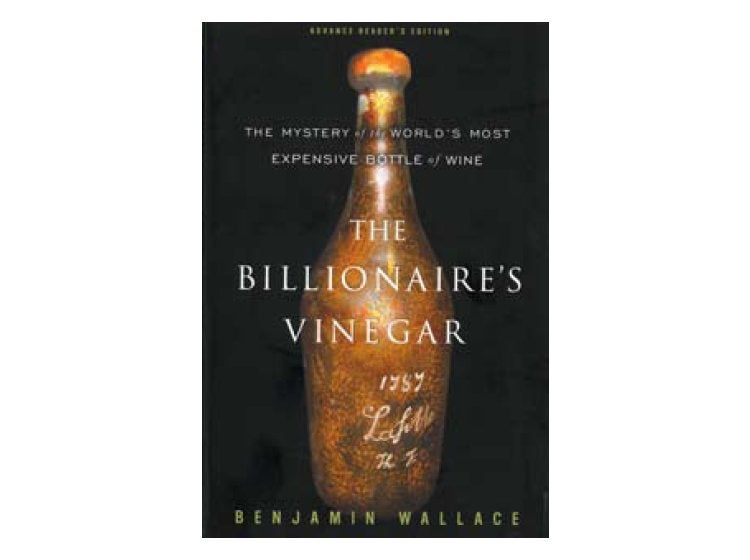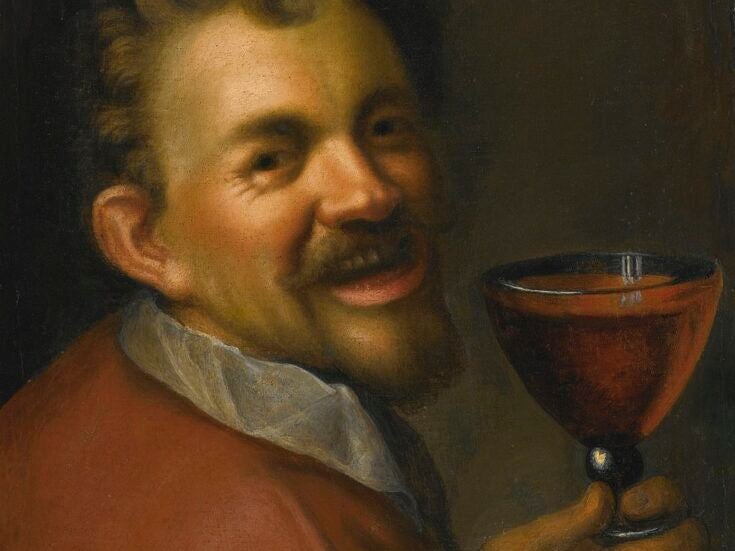
Benjamin Wallace,
The Billionaire’s Vinegar: The Mystery of the World’s Most Expensive Bottle of Wine
Published by Crown Publishers US$24.95
Reviewed by Jamie Goode
Benjamin Wallace’s new book tells the story of the “Jefferson” bottle of Château Lafite 1787, which, as lot 337 in the Christie’s auction of December 5, 1985, was the most expensive bottle of wine ever sold. It’s a story that brings together the disparate themes of wealth, greed, narcissism, ego, and fraud, with a dollop of history and some nifty detective work thrown in for good measure-and it’s a compelling read. Wallace’s book deserves the broad readership at which it is clearly aiming, reaching far beyond the confines of the wine trade and wine collectors.
What makes this such a good read is that it is as much about people as it is about wine. Center stage is Hardy Rodenstock, who may well currently be the most controversial figure in the world of fine wine. Joining him is an illustrious, colorful cast that includes Michael Broadbent MW, wealthy collectors, and assorted wine merchants and journalists.
Rodenstock is at the heart of this story because it is he who discovered the “Jefferson” bottles in Paris in 1985. The story goes thus. As American minister to France, Thomas Jefferson (later third president of the USA) had indulged his love of fine wine by buying reasonable quantities of top claret. (We know a lot about this side of his life because he recorded, in an obsessive fashion, almost every detail, however mundane, in his journals. These are still at Monticello, the Jefferson museum in Virginia.) For example, in February 1788, he ordered 250 bottles of Lafite. He placed the order directly because he was smart enough to realize that it was the only way to avoid the very real risk of adulteration at the hands of wine merchants. Then, in May of that year, he ordered 125 bottles of Haut-Brion. Jefferson was called back to the USA in 1789, however, to serve as Secretary of State, and in the chaos of the French Revolution some of the wine he ordered went missing. Is it possible that some of Jefferson’s wine remained in Paris, only to be unearthed some 200 years later?
The flamboyant Rodenstock, a noted wine collector, had developed something of a reputation for sniffing down caches of old, rare wine. Initially involving a small circle of like-minded collectors, his tastings grew into extravagant events at which numerous old, soughtafter bottles were opened-and these proceedings were often legitimized by the presence of wine-trade luminaries. Broadbent was a frequent attendee, and Jancis Robinson MW and Robert Parker have written up Rodenstock events.
In 1985 Rodenstock made his greatest find yet. It was a cache of around 100 bottles that had been walled up in a Parisian cellar. Two dozen of these bottles were engraved with the initials “Th.J” and were from the 1784 and 1787 vintages, including Lafite, Margaux, Yquem, and Branne-Mouton. Wallace claims that, at the time of the discovery, Rodenstock told one of his collector friends that the bottles belonged to Jefferson; Rodenstock later claimed that it was Yquem’s Alexandre de Lur-Saluces who first pointed out the connection between “Th.J” and Jefferson.
Indeed, Rodenstock was a particular fan of Yquem, and the first of these bottles to be opened was the 1787 vintage of this wine, in May 1985, with Lur-Saluces present. Another Yquem was opened in October that year, the 1784, and both Lur- Saluces and Broadbent attended. It was during this tasting that Broadbent persuaded Rodenstock to consign one of the Jefferson bottles to Christie’s. With the benefit of hindsight, Broadbent may have chosen to do differently, because this bottle set in chain the unfortunate series of events chronicled by Wallace.
Wallace traces the fate of the various Jefferson bottles. As well as the two Yquems consumed in 1985, two bottles (1784 and 1787 Lafite) were sold privately to Rodenstock’s collector friend Hans- Peter Frericks the same year. It was in December 1985 that the world-record auction bottle was sold to publisher Malcolm Forbes and placed on display in Forbes’s gallery, where the heat of the lights dried the cork out to such an extent that it fell into the wine. A 1787 Branne- Mouton was drunk at Château Mouton Rothschild in June 1986 and found to be drinkable. In December 1986, a 1784 Yquem was sold for £39,600 at Christie’s.
In March 1987, a half-bottle of 1784 Margaux was auctioned by Christie’s, selling for $30,000 to Wine Spectator publisher Marvin Shanken. The bottle was recorked by Broadbent, who found the small tasting sample he took to be drinkable still. In September of that year, Rodenstock opened another bottle-a 1787 Margaux; again, it was drinkable.
Rodenstock bartered a 1784 Lafite with collector Lloyd Flatt, and this was included in an extensive Lafite vertical held in October 1987. It turned out to be oxidized and undrinkable. Then, later that year, Rodenstock sold four more bottles of the cache to William Koch, a billionaire wine collector. Koch purchased the bottles through intermediaries (one through the Chicago Wine Company, and three through UK merchant Farr Vintners)- details that were to prove significant in the ensuing wrangling over the authenticity of these wines. A 1787 Margaux was purchased from Rodenstock by New York wine merchant Bill Sokolin but smashed in unusual circumstances in April 1989, with the insurers paying out $198,000. Then in 1998, at a Rodenstock Yquem extravaganza, two more Jefferson bottles (1784 and 1787) were served.
The book then begins to focus on the sorry tale of the legal proceedings over the authenticity of the Jefferson bottles, drawing into the discussion the thorny issue of counterfeit wine in general. Wallace does an excellent job in recounting this story, which is a difficult one to tell, especially in view of the ongoing litigation. In the absence of conclusive evidence, the easiest tack is to sit firmly on the fence, but this is not a course that Wallace takes, and the book is the better for it. While it is by no means a crusade-and both sides of the story are presented-Wallace leaves the reader in little doubt about his views.
He pulls no punches, portraying Rodenstock in a fairly negative light. Nor does Broadbent-the world’s leading authority on old, rare wine-come across terribly well in this account. His not-sosecret dislike of rival Serena Sutcliffe MW is given full treatment, and it is made clear that if many of Rodenstock’s amazing finds, including the Jefferson bottles, are one day shown conclusively to be fakes, then a portion of Broadbent’s writing on older wines will be called into question. But it would not only be Broadbent who would be shown to have been duped; other notables have written glowing reports on wines tasted at Rodenstock events, and there is a danger that if they, too, have been fooled in such a fashion, their professional reputations may also be tarnished. This in turn would reflect badly on the whole fine-wine venture. After all, if “experts” get it so badly wrong, who is getting it right?
Issues such as these make this wellwritten book such a compelling read. We are left with the reflection that, much as we would like it to be otherwise, many very old vintages of certain wines are exhausted. There may no longer be many hidden caches of old wines, stored in ideal conditions, waiting to be discovered. And very old wines, especially large-format bottles, without utterly impeccable provenance are to be viewed with great suspicion. Appropriately, Wallace closes his book thus: “In the last years of his life, Jefferson was reduced to drinking lesser wines. He abandoned his earlier habits of ordering straight from the châteaux, instead employing an agent in Nice and asking for simple wines of that region, even expressing a willingness to buy an imitation-Bordeaux merchant’s blend. Thomas Jefferson was drinking cheap table wine, and very happily so.”






